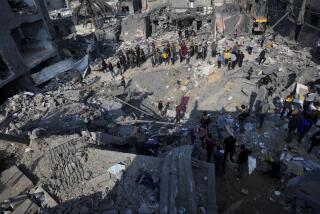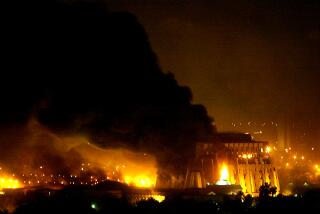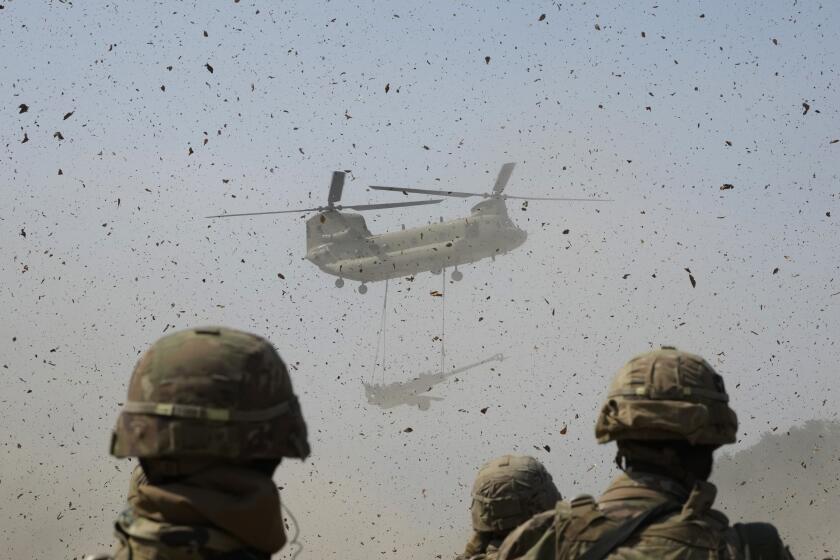The Price of Precision Bombing
- Share via
NEW YORK — When the history of our current war is written, one aspect is certain to provoke comment: the tremendous amount of information about the battlefield available to folks back home. Embedded reporters transmit instant video. Briefings are constant: from American military brass, from Iraqi officials, from aid organizations. Then there are the satellite images.
Television carried pictures of the bombs falling on Baghdad. Now we have high-quality satellite photographs that provide a bird’s-eye view of the American strategy to defeat the Iraqi regime -- and its results.
These images reveal a disturbing possibility: The strategy of the initial bombing may have been deeply flawed. The United States is unmatched in its precision-bombing capability, yet it sabotaged its own potential by placing undue faith in both the quality of its intelligence and the effects of its bombs.
Senior officers say that Gen. Tommy Franks and other military and civilian leaders understood the limitations of air power from the beginning. Though they would have been thrilled to kill Saddam Hussein and his inner circle in the early hours of the war, they assert that the war plan always involved a combined air and ground effort -- that no one really believed the regime could be defeated with air power alone.
But the entire war in Iraq is also based on a grand promise by the administration: that the United States can free the civilian population of Iraq without causing much suffering. It’s possible, given the rapid advances of the last couple of days, that the regime will collapse quickly. But it’s also possible that the end result of our initial strategy will be that the U.S. military has to finish the job by fighting in the streets of Baghdad, in which case all of the hard work to limit damage and civilian casualties in the capital city could be undone.
Which brings us back to the satellite photos.
On March 27, DigitalGlobe, one of two U.S. companies that own and operate private reconnaissance satellites, released images of Baghdad taken on the seventh day of regular bombing. DigitalGlobe operates QuickBird, a satellite camera orbiting about 280 miles above the Earth that can show objects on the ground as small as about 2 feet across. Its capabilities are on a par with U.S. spy satellites in the 1970s.
During the Afghanistan war, the Pentagon restricted the other satellite company, Space Imaging, from publicly transmitting any pictures from its Ikonos satellite. But as war in Iraq loomed, both companies were assured they would not face “shutter control.”
Such unrestricted satellite imagery has “democratized war fighting,” says Matthew McKinzie, a scientist with the Natural Resources Defense Council, which has analyzed the images for NBC. “We can almost see the same bomb damage photographs that the U.S. military is seeing,” he says. “We can not only see what physically happened, but also surmise what war planners were hoping to accomplish.”
So, what do the images tell us? First, they confirm our ability to hit with precision what we’ve targeted. But second, they call into question the efficacy of our early bombing strategy and reveal later attempts to correct its flaws.
The bulk of the bombing in downtown Baghdad has been in an area at the elbow of the Tigris River, a section of the city one-third the size of Manhattan containing three huge palace complexes, half a dozen bunkers, streets and offices open only to government officials, VIP homes and hundreds of military, intelligence and security offices and buildings.
Among the largest structures in the area was the riverside office complex of the president. Satellite images from March 27 show the results of early bombing of the offices: Three points were struck, two on the west wing and one in the center. The initial strikes almost certainly put the building out of commission, but here’s the rub: One whole side was untouched. If important officials were inside the structure when it was bombed early on and they were on the east side rather than the west, they could well have walked away.
Until March 27, the pattern was repeated over and over. Meticulously selected buildings and complexes were attacked with pinpoint precision. Installations associated with Hussein’s palace guards and special security organizations were the hardest hit, from headquarters all the way down to a building housing Hussein’s personal motor pool. But although some installations were hit with great force, others, like the office of the president, were struck with just a few bombs.
Part of the explanation is just that Hussein’s infrastructure is huge, and the U.S. could fly only so many missions. Strategists decided to focus bombing on security operations in an attempt to make the leadership more vulnerable to a coup. They hoped the regime was weak enough to be defeated merely by removing the protective screen around Hussein.
On Tuesday, DigitalGlobe and Space Imaging made available additional images of downtown. The new satellite photographs clearly document an enormous change of course in the bombing effort. Air war commanders concluded that their initial bombing runs, while accurate, may have been so spread out as to dilute their effect in any one location. And a number of Air Force officers have complained that scores of targets were initially removed from prospective lists because of excessive concern about civilian casualties.
No one could call more recent strikes halfhearted. Everything hit in the elbow of downtown Baghdad since March 27 has been struck much harder. New targets were added, many seemingly worthy of attack on the first day, such as the Baath Party’s exclusive Revolutionary Command Council headquarters. And old targets were hit again, with much more firepower.
At a VIP housing area south of the Al Sijood palace, an early satellite image showed evidence of an attempt to hit an underground bunker. Damage does not appear widespread. Images released Tuesday show evidence of another strike in the area indicating that 10 homes were obliterated. A gigantic crater and hole suggests the use of at least one “bunker busting” bomb against a deep underground facility. The satellite photos confirmed what Central Command was saying: Strikes on downtown Baghdad had considerably intensified.
But one has to ask if it wouldn’t have been better to have hit harder from the beginning. A more vigorous initial round of bombing might have stopped the Iraqi command in its tracks. Would that have caused more civilian casualties in the war’s early days and weeks? Quite possibly. But it might have prevented them later.
Iraqi strategy from the beginning of this war has been to neutralize America’s air power and its superiority on the ground by depending for its final defense on block-by-block guerrilla warfare. If that happens, some 5 million Baghdad civilians are likely to get caught in the cross-fire.
More to Read
Sign up for Essential California
The most important California stories and recommendations in your inbox every morning.
You may occasionally receive promotional content from the Los Angeles Times.













